Fields
Materials and Energy Course
Life and Materials Chemistry
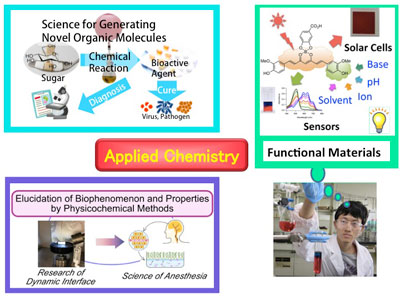
| Staff | Shuichi Iwata, Professor Katsuhiko Ono, Associate Professor Atsushi Miyagawa, Associate Professor Yasushi Yamamoto, Associate Professor |
|---|---|
| Keywords | Synthetic Organic Chemistry Supramolecular Chemistry Interfacial Science and Chemistry Bio-Related Chemistry Medical Chemistry |
| Hint to set learning objectives | The goal of our education and research is to study mainly the field of life science and materials chemistry and master the skill that designs and builds a molecule and aggregation freely. This goal also links to the research that participates in organic devices and medical functional materials. |
Soft Materials

| Staff | Katsuhiro Inomata, Professor Akinori Takasu, Professor Shin-ichi Matsuoka, Associate Professor |
|---|---|
| Keywords | Polymeric Materials Functional Plastics Protein, DNA Environmentally Compatible Polymers Environmentally Benign Polymer Synthesis |
| Hint to set learning objectives | Study on not only soft materials but also materials function and design engineering will lead to the development of highly functional organic materials, such as human friendly livingware, using tailor-made polymers. |
Advanced Ceramics
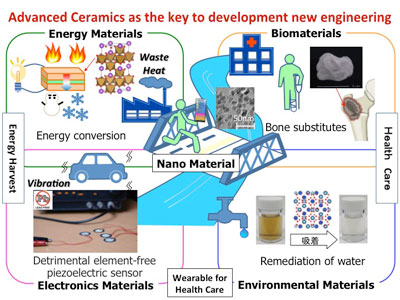
| Staff | Hirotaka Maeda, Professor Toru Asaka, Associate Professor Akiko Obata, Associate Professor Teruaki Fuchigami, Assistant Professor |
|---|---|
| Keywords | Biomaterial Hybrid material Functional nanomaterial Electronics Biomimetics |
| Hint to set learning objectives | This course is aimed at achieving an understanding of the Inorganic Materials Chemistry in addition to life science and electrical and electronic engineering. Finally, students will prepare novel environmentally friendly materials with high performances for bio-, energy-, environmental remediation-applications. |
Materials Function and Design
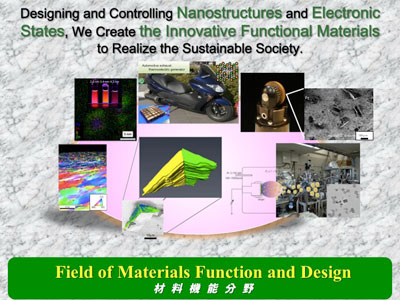
| Staff | Shochiku Kure, Professor Yasushi Hamanaka, Professor Takehiko Hihara, Professor Hisashi Sato, Professor Yoshimi Watanabe, Professor Hidetoshi Miyazaki, Associate Professor |
|---|---|
| Keywords | Nanoparticles, Thin films Composite and functionally graded materials Iron and steels, Light metals Photodevices Energy harvesting materials |
| Hint to set learning objectives | You can develop a novel energy source, such as power generating system using energy harvesting materials, if you learn the field of Materials Function and Design as well as Electrical and Electronic Engineering. |
Applied Physics
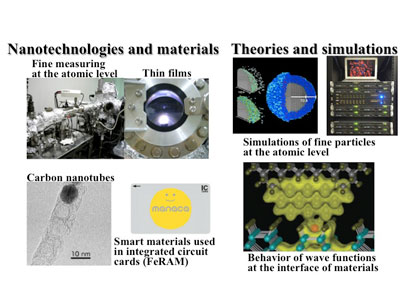
| Staff |
Makoto Iwata, Professor Shuji Ogata, Professor Ryo kobayashi, Assistant Professor Reina Miyagawa, Assistant Professor |
|---|---|
| Keywords | Simulations using supercomputers Thin films and nanomaterials Processing technologies at the atomic level Smart materials Femtosecond lasers |
| Hint to set learning objectives | On the basis of classes mainly in the applied physics course and additionally in the materials function course, we systematically teach physics of materials, methods of simulations, and processing technologies, and foster engineers who can develop new smart materials, sensors, and devices. |
Electrical and Electronic Engineering

| Staff |
Makoto Iwasaki, Professor Eiji Okamoto, Professor Takashi Kosaka, Professor Akimasa Hirata, Professor Mutsumi Aoki, Associate Professor Daisuke Anzai, Associate Professor Kenta Seki, Associate Professor |
|---|---|
| Keywords | Energy system Mechatronics System control Wireless communication technologies Bioelectromagnetic environment |
| Hint to set learning objectives | By learning the electrical and electronic engineering, together with information network, material, and design engineering, students will have an ability to develop an advanced Connected-Car contributing to a sustainable society. |
Mechanical Engineering
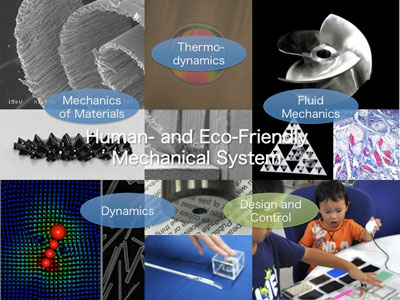
| Staff |
Fumihiro Itoigawa, Professor Syukei Sugita, Professor Yoshihiro Tanaka, Professor Yuhiro Iwamoto, Associate Professor Tatsuo Ushijima, Associate Professor Yu Saiki, Associate Professor |
|---|---|
| Keywords | Flow Science, Energy Use and Control, Vibration Control, Micro-Nano Mechanics, Human Interface |
| Hint to set learning objectives | Around the main discipline of mechanical engineering, you can research and develop human- and eco-friendly mechanical systems, adding other fields like electrical and electronics engineering, Computational Intelligence, media infomatics. |
Computer and Social Engineering Course
Networks
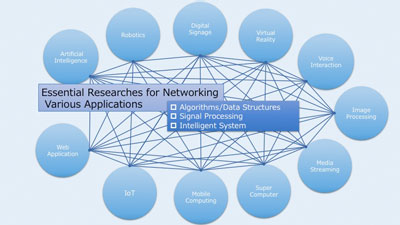
| Staff |
Takahiro Uchiya, Professor Tadashi Wadayama, Professor Norishige Fukushima, Associate Professor |
|---|---|
| Keywords | Web Application Mobile Computing Image Processing Algorithm Distributed System |
| Hint to set learning objectives | Studying the network program with design engineering, media and intelligence information technology, and electrical and electronic engineering, researches and services on integrating various fields are expected. |
Computational Intelligence

| Staff | Nobuhiro Inuzuka, Professor Tadachika Ozono, Professor Shohei Kato, Professor Shun Shiramatsu, Professor Koichi Moriyama, Associate Professor |
|---|---|
| Keywords | Artificial Intelligence Social Computing Multi-Agent System Intelligent Robotics Brain Science |
| Hint to set learning objectives | For example, learning Life and Materials Chemistry, Soft Materials, and Applied Physics in addition to the main study theme, Computational Intelligence, enables students to develop systems for computer-aided drug design simulation or bioinformatics-related systems. |
Multimedia and Human Computer Interaction
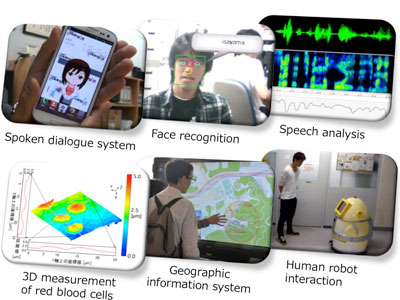
| Staff | Keiichi Tokuda, Professor Ryo Taguchi, Associate Professor Yoshihiko Nankaku, Associate Professor Daisuke Yamamoto, Associate Professor Tatsuya Yokota, Associate Professor |
|---|---|
| Keywords | Speech recognition and speech synthesis Image recognition and image understanding Multimedia system Augmented reality |
| Hint to set learning objectives | Next-generation human-computer interaction systems can be developed by learning computational intelligence, networks and electrical and electronic engineering in addition to the field of multimedia and human computer interaction. |
Architecture and Design

| Staff | Takeyoshi Ishimatsu, Professor Hideki Idota, Professor Toshiyuki Kaneda, Professor Keisuke Kitagawa, Professor Atsushi Sato, Professor |
|---|---|
| Keywords | Architectural Design Architectural Theory and History Architectural Structure and Material Architectural Planning and Urban Planning Environmental Design and Figurative Art |
| Hint to set learning objectives | Students acquire advanced knowledge and skills related to architecture and design, pursuit kinds of safeties and comforts from various viewpoints of architectural design, architectural theory, architectural structure and material, architectural planning, urban planning, environmental design and so on, and develop researches about space to be better places for human life. |
Civil and Environmental Engineering

| Staff | Eizo Hideshima,Professor Michiko Masuda,Professor Kazutoshi Nagata,Associate Professor |
|---|---|
| Keyword | social infrastructure lifeline sustainable society conservation management urban safety design |
| Hint to set learning objectives | This field requests to study civil and environmental engineering, with technologies including ICT and management skills, to improve and arrange the built and natural environments to support our lives and industries. The students are expected to be proficient civil engineers or capable researchers. |
System Management and Engineering

| Staff | Naoe Imura, Professor Junichi Yokoyama, Professor Kenji Watanabe, Professor |
|---|---|
| Keywords | Risk Management Critical Infrastructure Protection Engineer Resource Management Technology & Product Development System Thinking |
| Hint to set learning objectives | This course provides opportunity to learn network & intelligent information and mechanical engineering addition to our major field, management systems, at the same time. Based on this unique opportunity, newly developed management methodologies or ability for system thinking, the fundamentals for management at any corporations and public agencies, are expected to be implemented as practical technology developments. |
